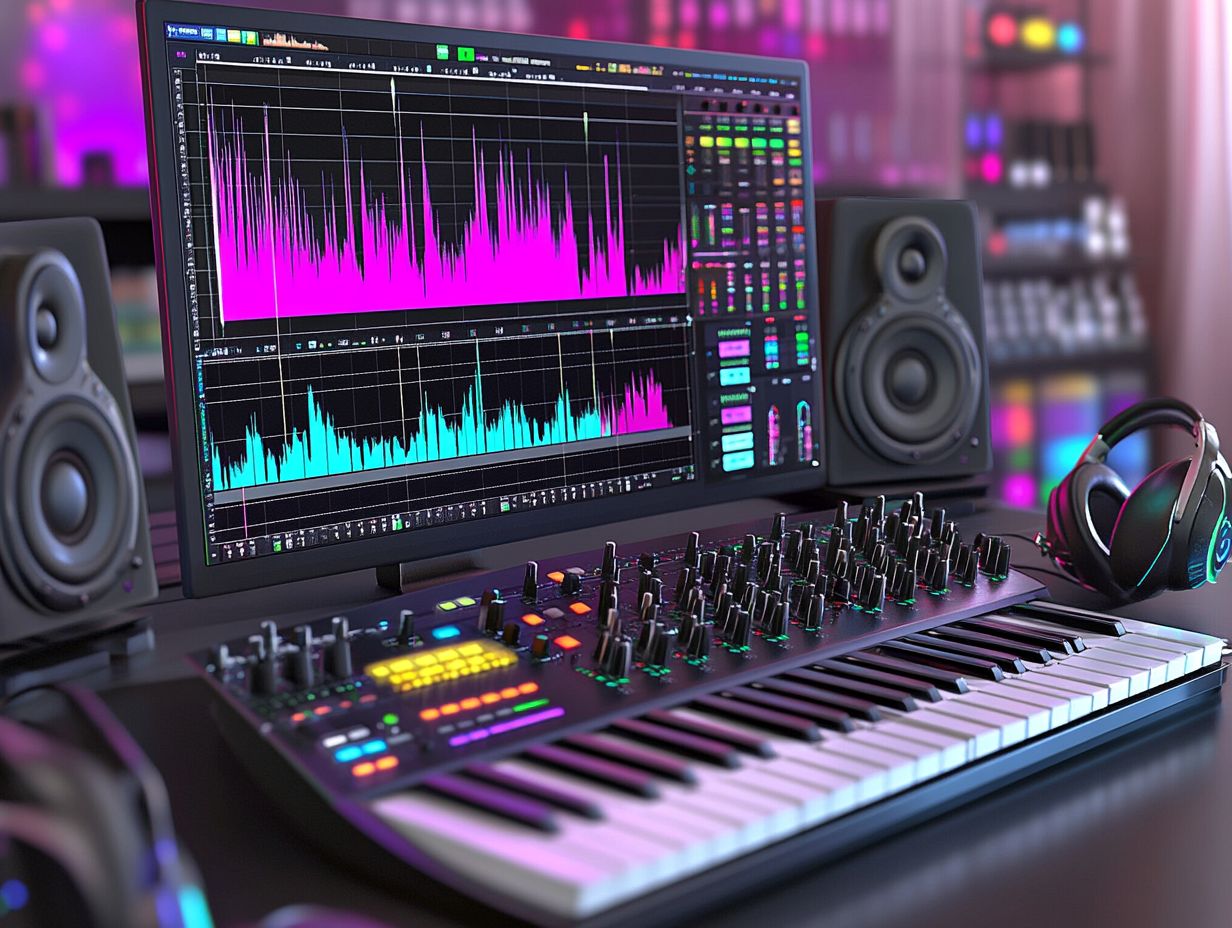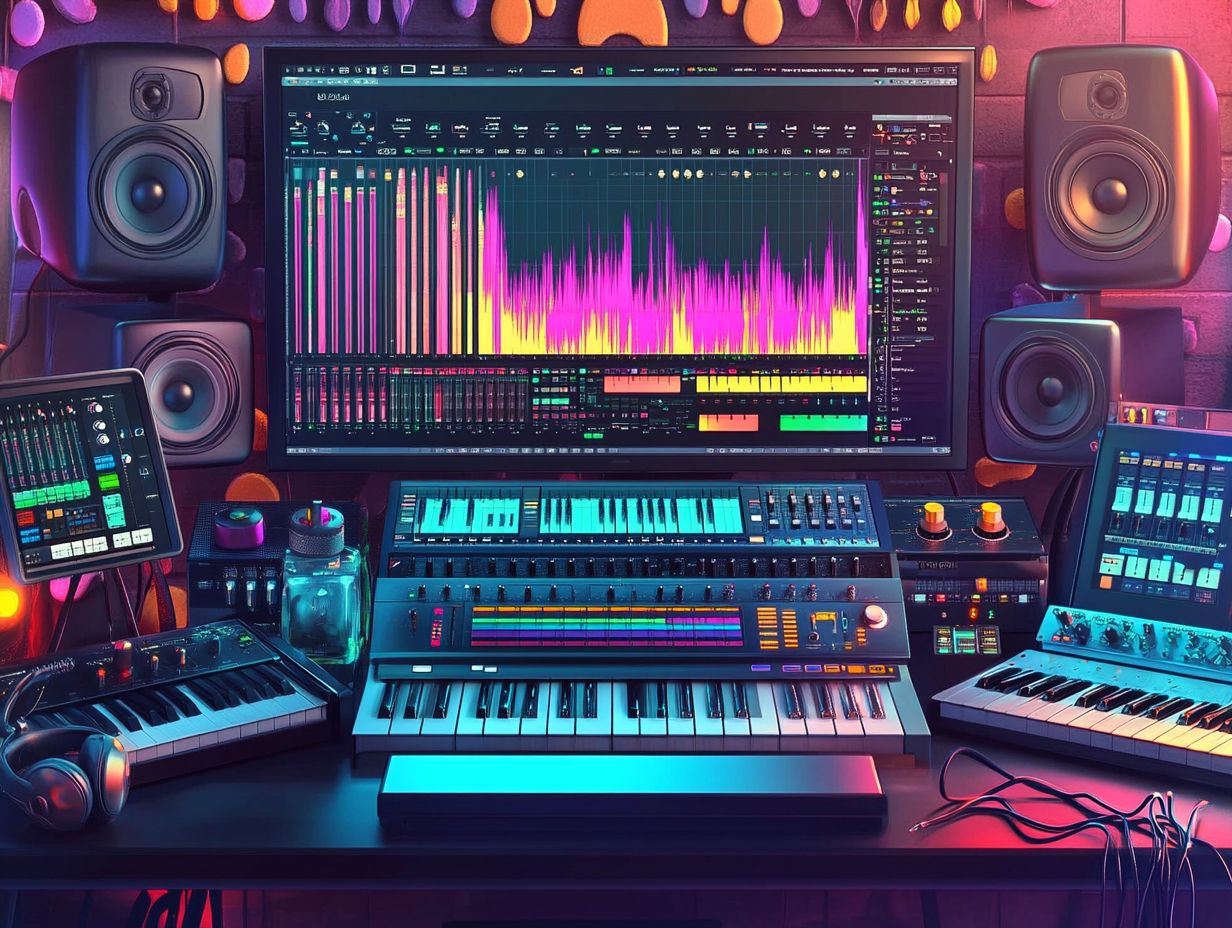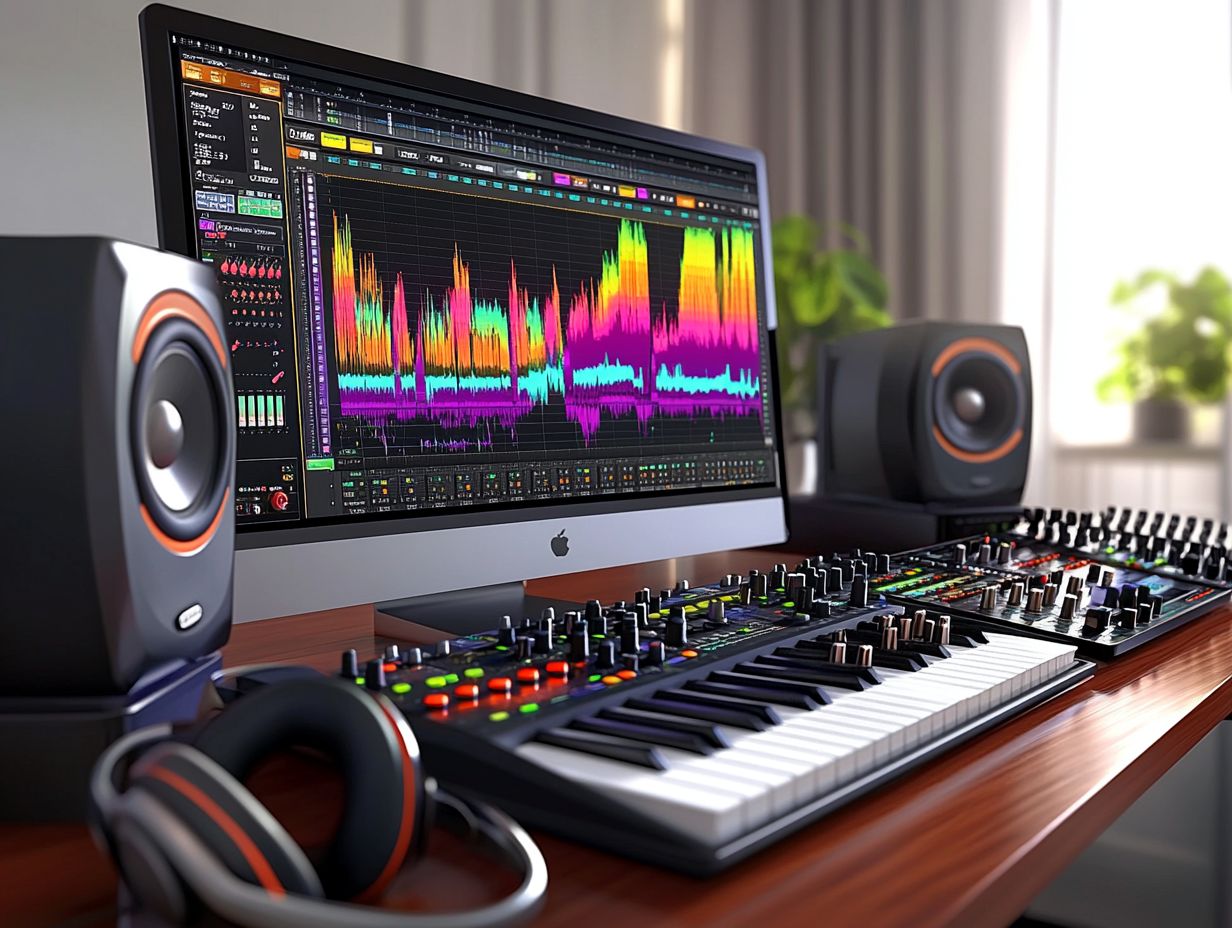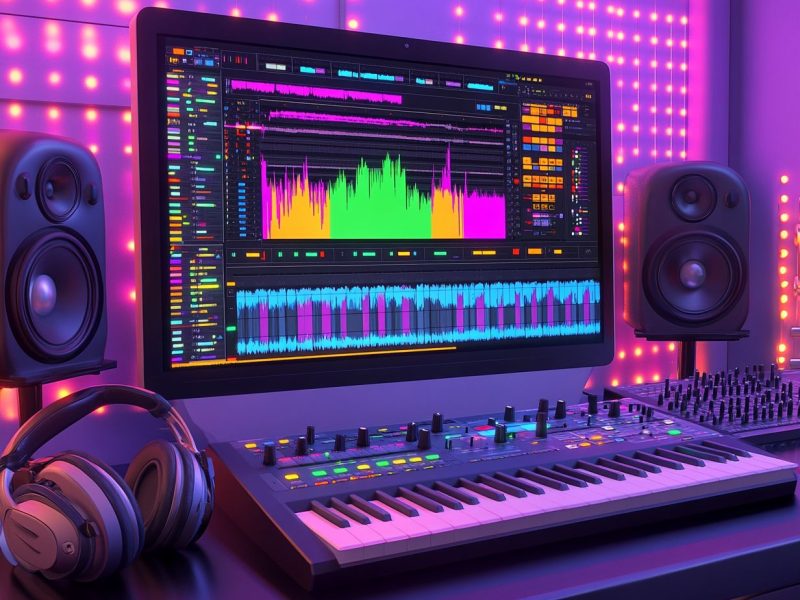In the contemporary digital landscape, music production software has emerged as an essential tool for both aspiring musicians and experienced producers.
With a diverse array of options available, comprehending the various types of software—ranging from Digital Audio Workstations (DAWs) to virtual instruments and editing tools—can significantly enhance the creative process.
This article examines the key features to consider when selecting the appropriate software, highlights some of the leading options currently available in the market, and provides insights to assist in making an informed choice for music production requirements.
Whether one is just beginning or seeking to upgrade an existing setup, this resource offers valuable information for all individuals involved in music production.
What is Music Production Software?

Music production software comprises a comprehensive array of tools and applications specifically designed to aid musicians, producers, and audio engineers in the processes of creating, recording, editing, and mixing music.
These advanced digital audio workstations (DAWs) serve as a platform for music composition, audio editing, and recording, integrating numerous features and functionalities that enhance the music production workflow.
Regardless of whether one is a novice or an experienced professional, it is imperative to understand the capabilities of music production software to achieve high-quality audio output and to enrich the creative process. From MIDI sequencers to virtual instruments, the appropriate software can have a significant influence on the overall music production experience.
Types of Music Production Software
There are various types of music production software available, each designed to fulfill specific functions within the music creation and production process.
The most widely utilized software includes digital audio workstations (DAWs), which offer a comprehensive suite of tools for recording, editing, and mixing audio tracks.
Furthermore, virtual instruments and effects plugins are employed to enhance sound design and music composition. In addition, audio editing software facilitates precise manipulation of audio, while mixing software provides specialized tools for achieving a balanced sound mix across different music genres.
Digital Audio Workstations (DAWs)
Digital Audio Workstations (DAWs) serve as the cornerstone of music production, providing a comprehensive environment for recording, editing, and mixing audio tracks. They encompass a variety of features, including MIDI sequencing, audio editing capabilities, and advanced mixing tools, which cater to a diverse range of music genres, from electronic to acoustic compositions.
Notable DAWs such as Ableton Live, FL Studio, and Pro Tools have become essential tools for music producers, facilitating efficient workflows and collaboration within the music production landscape.
These sophisticated software platforms also integrate virtual instruments and effects, enabling users to explore a vast array of sound design possibilities.
For example, Ableton Live is particularly adept at live performance and loop-based composition, making it a preferred choice among electronic music artists. Conversely, Pro Tools is recognized for its professional audio editing and mixing capabilities, appealing to individuals working in studio environments on intricate projects.
Given their versatility, DAWs are not merely tools; they constitute the backbone of contemporary music creativity, adapting to the specific requirements of each genre while enableing artists to actualize their sonic visions.
Virtual Instruments and Effects Plugins
Virtual instruments and effects plugins are integral components of contemporary music production, enabling musicians to integrate a wide variety of sounds and effects into their projects. These tools, frequently available as VST (Virtual Studio Technology) plugins, facilitate sound design and music composition by providing realistic emulations of acoustic instruments, synthesizers, and an array of audio effects.
They enhance creativity and broaden the sonic possibilities for producers, rendering them essential in today’s music production environment.
With the capability to manipulate sound in ways that were once exclusive to costly hardware, these plugins support not only straightforward arrangements but also intricate, layered compositions that can invigorate any genre. Producers can seamlessly experiment with diverse textures and timbres, layering virtual instruments to construct rich soundscapes or employing effects plugins to meticulously shape their mixes.
As technology continues to advance, many developers are committed to regularly updating their offerings, ensuring that artists have access to the latest innovations in sound design that continually push the boundaries of musical creativity.
Audio Editing and Mixing Software
Audio editing and mixing software are essential tools for refining recorded audio tracks and achieving a professional quality in music production. These applications offer a comprehensive range of audio editing capabilities, including audio effects, track automation, and sound mixing techniques, enabling producers to enhance their compositions through precise adjustments.
Mixing software facilitates the achievement of the desired dynamic range and balance, while mastering software prepares the tracks for distribution, ensuring compliance with industry standards.
Beyond these fundamental functions, such software includes various plug-ins that can introduce sophisticated audio effects, resulting in rich and textured soundscapes. Users can manipulate frequencies and apply compression to enhance the audio’s clarity, which is essential for both music production and film soundtracks.
The intuitive user interfaces of these programs often allow even novice users to explore advanced mixing techniques, promoting creativity and innovation. By leveraging these powerful audio mastering tools, artists can transform their raw recordings into polished masterpieces that resonate with audiences and differentiate themselves in a competitive market.
Features to Look for in Music Production Software

When selecting music production software, it is essential to consider several key features to ensure that it aligns with specific needs and enhances the music production workflow.
Important aspects to evaluate include:
- A user-friendly interface that facilitates ease of navigation
- Advanced editing capabilities for detailed audio manipulation
- Comprehensive mixing features that support intricate sound design and arrangement
Furthermore, compatibility with various plugins and virtual instruments can greatly enhance the software’s versatility across different music genres.
Compatibility and Integration
Compatibility and integration are essential factors to evaluate when selecting music production software, as they significantly influence the software’s effectiveness in conjunction with existing hardware and other tools.
Ensuring that the Digital Audio Workstation (DAW) can communicate efficiently with your audio interface, MIDI controllers, and external plugins is crucial for enhancing the overall music production workflow. Support for various audio formats and file types facilitates seamless collaboration and project sharing among music producers.
When these elements align effectively, they streamline the creative process and minimize technical challenges that could impede productivity. A well-integrated system fosters the efficient use of resources, allowing musicians to concentrate on their artistry rather than contend with connectivity issues.
In collaborative settings, compatibility with diverse platforms and devices ensures that all participants can engage without concerns about version discrepancies or file incompatibilities. Ultimately, a harmonized setup establishes a solid foundation for enhanced creativity and improved project outcomes.
Interface and User Experience
A well-designed user interface plays a crucial role in shaping the overall experience of utilizing music production software, as it fundamentally influences the ease with which users can navigate various features and tools. An intuitive interface enhances workflow, allowing music producers to concentrate more on their creative endeavors rather than becoming hindered by technical complexities.
The user experience must accommodate various music genres and production styles, providing customization options that facilitate a personalized approach to music creation.
In today’s competitive landscape, where numerous performance software options are available, the significance of a clear and engaging interface cannot be overstated. Producers working within genres such as electronic, hip-hop, or orchestral music require software that not only meets their specific needs but also promotes seamless interaction with their sound palettes.
A thoughtfully designed interface reduces distractions and enables users to experiment freely, thereby facilitating a smoother transition from concept to composition. Consequently, equipment with adjustable layouts and user-friendly controls is essential for enhancing creativity and productivity, proving essential for music makers at all levels.
Advanced Editing and Mixing Capabilities
Advanced editing and mixing capabilities are critical features in music production software that enable users to achieve professional-quality audio. These capabilities encompass comprehensive audio editing tools, a diverse array of audio effects, and sophisticated track automation options, all of which provide producers with enhanced control over their sound.
By leveraging advanced tools such as equalization adjustments, dynamic range control, and innovative effects like reverb and delay, creators can elevate their projects to new heights. The ability to automate track parameters introduces an additional layer of creativity, facilitating seamless transitions and nuanced changes that engage listeners.
With precise sound mixing options readily available, artists not only refine their audio but also enhance their narrative through music, resulting in a finished product that resonates profoundly and distinguishes itself in the competitive landscape of the music industry.
Top Music Production Software on the Market
The market for music production software is extensive, offering a wide array of options tailored to diverse needs, skill levels, and musical genres.
Prominent Digital Audio Workstations (DAWs) such as Ableton Live, Logic Pro, and FL Studio dominate the industry, each providing distinctive features and workflows that cater to various music production styles.
Furthermore, there is a multitude of plugins and music production applications that augment the functionality of these DAWs, rendering them essential tools for both aspiring musicians and professional producers.
Overview of Popular DAWs and Plugins

An overview of popular Digital Audio Workstations (DAWs) and plugins reveals a diverse array of options available to music producers aiming to enhance their audio production capabilities. From industry-standard DAWs such as Pro Tools and Cubase to innovative plugins like Serum and Kontakt, each tool presents distinct features and advantages that cater to various aspects of music production.
A comprehensive understanding of these options is essential for selecting the appropriate combination of software that aligns with one’s workflow and creative style.
For instance, Pro Tools is highly regarded for its advanced audio editing capabilities, making it the preferred choice for professionals focusing on detailed sound design or post-production work. Conversely, Ableton Live excels in live performance settings, offering exceptional flexibility for real-time music creation.
In terms of plugins, Serum distinguishes itself through its wavetable synthesis and user-friendly interface, attracting those who seek vibrant sound textures. Meanwhile, Kontakt boasts an extensive library of high-quality instrument samples, which is ideal for producers aiming to add depth and realism to their compositions.
By exploring these tools, music producers can effectively tailor their production processes to achieve desired outcomes and enhance collaboration with fellow artists.
Choosing the Right Software for Your Needs
Selecting the appropriate music production software is crucial as it can greatly impact the creative process and overall output. It is essential to assess individual needs and preferences when making this decision.
Key factors to consider include:
- the user’s level of experience,
- preferred music genres,
- and specific production goals.
Furthermore, evaluating the compatibility of the software with existing music production equipment and collaboration tools can significantly improve workflow and facilitate seamless integration into the creative setup.
Considerations and Recommendations
When evaluating music production software, it is crucial to assess several key factors to ensure alignment with one’s creative objectives and workflow. Recommendations from the music production community can provide valuable insights, as experienced producers often share their preferences and experiences with various digital audio workstations (DAWs), plugins, and tools.
The emergence of mobile music production necessitates consideration of software options that offer both portability and functionality for music creation on the go.
A comprehensive understanding of the specific features provided by each software option can significantly influence the quality and efficiency of projects. One should seek software that supports a variety of file formats and offers intuitive interfaces, as these elements can enhance the overall workflow.
Furthermore, features such as MIDI support, virtual instruments, and sound libraries are essential for fostering creativity. Actively participating in community forums can reveal lesser-known tools within the vast array of available options, as users frequently discuss updates, bugs, and effective workarounds that can save valuable time.
Ultimately, engaging in these discussions cultivates a sense of community and enables individuals to make informed decisions, contributing to a successful music production journey.
Frequently Asked Questions
What is essential music production software?
Essential music production software refers to digital tools and programs that are necessary for creating, editing, and producing music. These programs are designed to help musicians and producers with tasks such as recording, mixing, and mastering audio.
What are some features to look for in essential music production software?

Some important features to look for in essential music production software include a user-friendly interface, a wide selection of virtual instruments and effects, compatibility with different file formats, and the ability to easily export and share projects.
Which operating systems are compatible with essential music production software?
Most essential music production software is compatible with both Mac and Windows operating systems. Some programs may also offer mobile versions for use on iOS and Android devices.
Can essential music production software be used for live performances?
Yes, some essential music production software offers features specifically designed for live performances, such as loop triggering, Midi mapping, and virtual instrument control. However, it is important to check the system requirements and capabilities of the software before using it for live performances.
Are there any free options for essential music production software?
Yes, there are several free options for essential music production software, such as GarageBand for Mac users and LMMS for both Mac and Windows users. These programs may have more limited features compared to paid software, but they can still be a great starting point for beginners or those on a budget.
Do I need any additional hardware to use essential music production software?
While some essential music production software may require additional hardware, such as a MIDI controller or audio interface, many programs can be used with just a computer and headphones. It is important to read the system requirements and recommendations for the specific software you are using.


 Studio Monitors vs Headphones: Choosing the Best Audio Equipment
Studio Monitors vs Headphones: Choosing the Best Audio Equipment